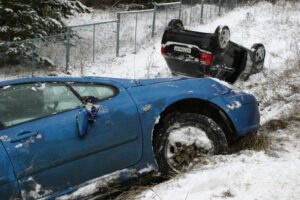
Fault is the central question in any Georgia car accident case. Georgia is a “fault state,” meaning that every driver must carry insurance, and each driver’s policy will pay for any accidents that they caused. Unfortunately, determining who caused the accident is not always easy. In some cases, one driver is obviously at fault, while in others it’s unclear. The waters get even muddier when you consider that many insurance companies will try to cast blame on the other driver purely to reduce how much money they have to pay.
The Basic Rules of Fault
The basic rules of fault are simple:
- If one person broke a traffic law, and the other did not, the lawbreaker is probably at fault.
- If one person drove negligently, such as fiddling with the radio instead of paying attention to the road, that person is probably at fault.
- If one car wasn’t properly maintained, and this led to an accident (such as the brakes going out), that car’s driver is probably at fault.
- Last, in a rear-end accident, the person in the back is usually at fault, because they were following too closely. The exception is if the person in front drove erratically, such as changing lanes suddenly, or if there was a multi-car pileup that the person in the back couldn’t control.
Many real-life accidents involve circumstances that aren’t as clear. For example, what if one driver was speeding but the other one wasn’t paying attention to the road? What if both drivers broke a law? This is where some judgment is needed.
Get the strong arm
Who Decides Fault in a Car Accident?
In every accident, when you file a claim with an insurance company they will assign an adjuster to look at the case. The adjuster reviews basic facts about what happened and then gives an opinion on who was at fault. They look at evidence including:
- The police report from the accident
- Statements from both drivers and any witnesses
- Information about the accident scene itself (such as skid marks from stopping suddenly)
- Weather conditions for the day and time of the accident
- The physical condition of the cars (the type of damage and how it likely happened)
They will use all of this information to reconstruct what happened and assign fault. But they are biased, and they will look for any opportunity to make their own client look innocent and cast the blame on you. This is why it’s essential to have a car accident lawyer who can pressure the insurance company for a fair offer.
Can Both Drivers Be At Fault?
Yes. In Georgia, and many states, fault can now be shared between both drivers. This is known as comparative fault. It’s basically a system for evaluating how fault should be shared when both drivers may have been negligent in some way.
In the past, if you were even a little bit negligent, you wouldn’t be able to recover any money for your accident. If it was 5% your fault, you got nothing. Today, under Georgia’s comparative negligence rule, if you were 5% at fault you’d be allowed to recover most of your costs, just not quite as much as if you were completely fault-free.
How Comparative Fault Works
There are two main rules for how comparative fault works:
- You can recover damages in proportion to how much the other driver was at fault. For example, if the other driver was 70% at fault in the accident, you can recover 70% of your total costs.
- If you were at least 50% at fault, however, you cannot recover anything.
This creates a situation where insurance companies have an incentive to drive up your fault as much as possible. If they can claim you were even a little at fault, they can save money. And if they can claim it was a 50/50 fault situation, they can walk away without paying you at all. Insurance companies are very good at playing the fault game—do not take them on without a good lawyer representing you.
Contact Our Attorneys Today for Help Proving Fault in Your Accident
John Foy & Associates offers a free consultation with some of the most experienced and respected personal injury lawyers in Georgia. Fill out the form to your right or call us to get yours today!
(404) 400-4000 or complete a Free Case Evaluation form





